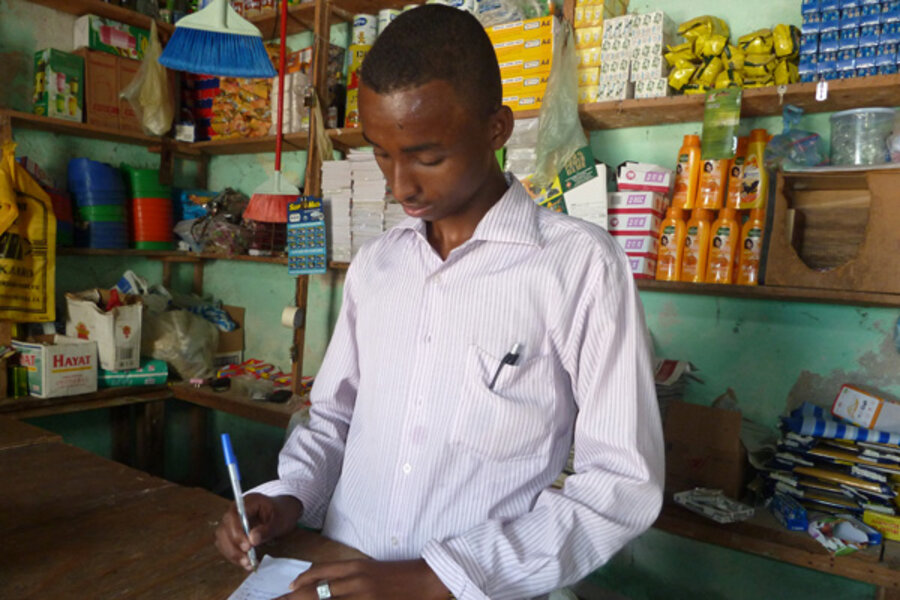In Somalia, optimism rises
Loading...
| Mogadishu, Somalia
A little over a year ago, perhaps the most common sound heard on a Mogadishu morning, after the muezzin’s call to prayers, was gunfire.
Back then, an army of African Union soldiers was battling Al Shabab, an Islamist militia encamped in foxholes and sniper positions dotted throughout Somalia’s seaside capital.
Today, you’re more likely to hear the clang of hammers and the drone of drills.
On Aug. 6, Mogadishans celebrated a year to the day since Al Shabab, now partnered with Al Qaeda, slunk out of the city’s center under cover of darkness, leaving it to government forces. Within weeks, Shabab’s fighters would be pushed from Mogadishu’s margins, too.
“This used to be a place where misdirected mortars always fell ... and people were killed daily,” says Nur Ibrahim Adan, a shopkeeper at Bakara Market, once an Al Shabab stronghold.
“Now there is a great change. There is no fear; there are no casualties. There are new buildings, new customers. Already my profit is much higher.” He’s persuaded things will stay quiet so long as African Union soldiers remain.
Somalia’s capital is in the midst of a transformation of greater significance, happening at greater speed, than at any time in the past 20 years, bringing cautious hope that a measure of peace may finally be taking root. The shift started with the removal of Al Shabab, beginning early on Aug. 6, 2011, after months of daily bombardment by the African Union mission, AMISOM.
Now traders who no longer fear stray bullets or mortar blasts are repainting and refitting glass to their shopfronts. Solar-powered streetlights brighten evenings along newly patched roads that marked front lines just a year ago.
Down at Lido Beach, where couples on Vespa scooters cruised the palm-lined promenade in prewar times, the sea is again dotted with swimmers and the beach hosts volleyball players.
Remittances from abroad have increased by 20 percent since January, according to Dahabshiil, an international money-transfer firm. The Somali shilling has strengthened by almost 50 percent against the dollar in 12 months.
“People realized that we now had security when we saw there was no more fighting and no more bombings, and every area became populated again,” says Farah Jimale, owner of Cosmetics Center at Bur Ubax in Bakara Market. “Now truly there is opportunity here and I have many new customers.
“Al Shabab, though, it is a group full of clever tactics,” he adds. “I am concerned they can come back. Already they are killing government officials. It is hard not to worry.”
The Islamist army, while weakened, is far from defeated. Only Mogadishu and a clutch of other towns are in government hands. Al Shabab still controls much of Somalia’s rural south, and the major port city of Kismayo.
Its commanders boast that the withdrawal from Mogadishu was strategic rethink; that it has shifted from a guerrilla army holding territory to what one analyst termed “a true hit-and-run terror group.”
“Now we are saving money, while the enemy pays more and more to secure land it seized, recruit new soldiers, pay for services,” Sheikh Mohamed Ibrahim, an Al Shabab commander, tells the Monitor. “Do you think really they can continue like that forever? Already we are in Mogadishu every night, carrying out missions.”
But the greatest obstacle to Mogadishu’s rise is Somalia’s leadership, says J. Peter Pham, director of the Michael S. Ansari Africa Center at the Atlantic Council in Washington. “There’s still no government presence, in terms of offering services or administrating, in the space that’s been opened up by forcing Shabab out,” he says.
The government also faces an Aug. 20 deadline – described by Dr. Pham as “impossible” – when Somalia’s transitional government must cede power.







